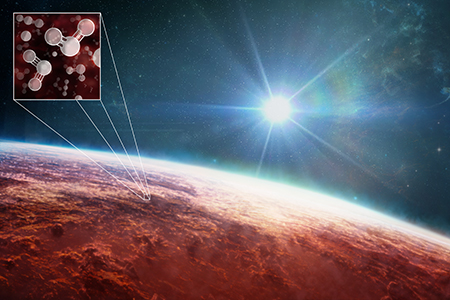Campus News
New JWST data reveal more details of exoplanet WASP-39b’s atmosphere
A ‘mystery molecule’ seen in the initial spectrum has been identified as sulfur dioxide produced by photochemical reactions in the planet’s atmosphere.

New observations of WASP-39b with the James Webb Space Telescope have provided a clearer picture of the exoplanet, showing the presence of sodium, potassium, water, carbon dioxide, carbon monoxide and sulfur dioxide in the planet's atmosphere. This artist's illustration also displays newly detected patches of clouds scattered across the planet. Credit: Melissa Weiss/Center for Astrophysics | Harvard & Smithsonian

New results from the JWST Transiting Exoplanet team reveal a full menu of the atoms and molecules that make up the atmosphere of the exoplanet WASP-39b, including the first photochemical by-product detected on an exoplanet.
Initial results from observations of WASP-39b with the James Webb Space Telescope (JWST), reported in August, included the first unequivocal detection of carbon dioxide in an exoplanet atmosphere. At the time, the team noted an interesting feature in their results but had not yet identified the molecule responsible for it.
Now they have identified the “mystery molecule” as sulfur dioxide and determined that it is produced by photochemistry—chemical reactions in the atmosphere driven by light from the planet’s host star, similar to the formation of ozone by photochemical reactions in Earth’s atmosphere.
“The discovery of photochemistry in the atmosphere of a ‘hot Jupiter’ exoplanet like WASP-39b is important, allowing us to test our photochemistry models and opening new avenues of investigation,” said Natalie Batalha, a professor of astronomy and astrophysics at UC Santa Cruz who leads the JWST Transiting Exoplanet Early Release Science Team.
The team reported their latest findings in a set of five new papers, three of which are in press and two of which are under review. They observed the planet as it passed in front of its host star, enabling them to analyze the starlight transmitted through the planet’s atmosphere, using spectroscopy to separate the light into its component wavelengths and reveal the “fingerprints” of the molecules that make up the planet’s atmosphere.
“We see a panoply of atoms and molecules in the atmosphere of WASP-39b, including sodium, potassium, water, carbon dioxide, carbon monoxide, and the mystery molecule, sulfur dioxide,” Batalha said. “The process used to identify molecules also gives us information about elemental abundance ratios—such as the ratios of carbon to oxygen and potassium to oxygen—which are tracers of planet formation processes.”
WASP-39 b’s chemical inventory suggests a history of smashups and mergers of smaller bodies called planetesimals to create an eventual goliath of a planet.
“The abundance of sulfur [relative to] hydrogen indicated that the planet presumably experienced significant accretion of planetesimals that can deliver [these ingredients] to the atmosphere,” said Kazumasa Ohno, a postdoctoral fellow at UC Santa Cruz who worked on the Webb data. “The data also indicates that the oxygen is a lot more abundant than the carbon in the atmosphere. This potentially indicates that WASP-39 b originally formed far away from the central star.”
The results also showed evidence of patchy clouds in the exoplanet’s atmosphere.
WASP-39b is a hot Saturn-mass gas giant exoplanet orbiting very close to its host star. Its close orbit and high temperature are typical of the abundant “hot Jupiter” class of exoplanets. The planet’s proximity to its host star—eight times closer than Mercury is to our Sun—makes it a laboratory for studying the effects of radiation from host stars on exoplanets. Better knowledge of the star-planet connection should bring a deeper understanding of how these processes create the diversity of planets observed in the galaxy.
The team obtained transmission spectra during four transits of WASP-39b, using three different instruments on JWST: NIRSpec (in two different observing modes), NIRISS, and NIRCam. This yielded transmission spectroscopy data covering the infrared wavelengths from 1 to 5 microns.
“The broad wavelength coverage provides a more complete picture of the conditions in the atmosphere,” Batalha said. “Moreover, each transit observation yields a planetary spectrum at distinct but overlapping wavelengths, allowing us to test the reproducibility of each instrument.”
The spectra from different instruments were consistent in the overlap regions. All the instruments performed at or above expectations, which is good news for astronomers planning future observations. That includes probing the atmospheres of smaller, rocky planets like those in the TRAPPIST-1 system.
The following papers from the JWST Transiting Exoplanets Early Release Science Program are currently available online:
- Early Release Science of the exoplanet WASP-39b with JWST NIRSpec G395H (Alderson et al.) https://arxiv.org/abs/2211.10488
- Early Release Science of the exoplanet WASP-39b with JWST NIRSpec PRISM (Rustamkulov et al.) https://arxiv.org/abs/2211.10487
- Early Release Science of the exoplanet WASP-39b with JWST NIRCam (Ahrer et al.) https://arxiv.org/abs/2211.10489
- Early Release Science of the exoplanet WASP-39b with JWST NIRISS (Feinstein et al.) https://arxiv.org/abs/2211.10493
- Direct Evidence of Photochemistry in an Exoplanet Atmosphere (Tsai et al.) https://arxiv.org/abs/2211.10490